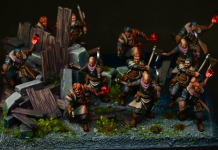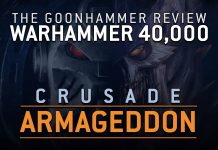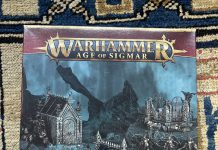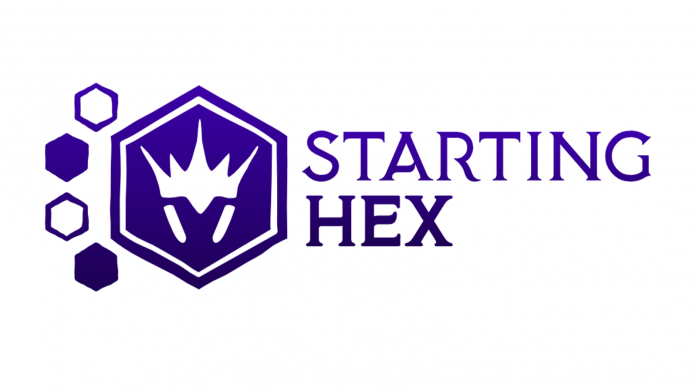Welcome to the first Starting Hex article! This is a series in which I write about Warhammer Underworlds, the game that has fully captured my attention for the past year or so. I’m coming at this game as a relative newcomer with a focus on improving gameplay, building communities, and a maybe even painting some models.
Some of you may know Warhammer Underworlds as “where those cool looking models come from.” Maybe you looked into the game years ago and thought the card chasing aspect was overwhelming so you passed on it (spoiler: this is not how it works anymore!). Or you may have no idea what this game is at all. This should serve as a quick overview of the game, what makes it unique, and why I find it so dang fun.
Game Overview
Warhammer Underworlds is a hybrid game that combines aspects of a board game, card game, and miniatures game. Given that description, the components of the game aren’t going to be anything too surprising. Each player brings a game board that is roughly 16.5” x 10.5” with a grid of hexagons. The two boards are placed together on the table to create the battlefield. On this playing area, each player places and controls a warband containing three to seven models. Finally, each player also has two small decks of objective and power cards (12 and 20 respectively) that are used throughout the game. The dice used in the game are D6s, but with unique symbols on the faces instead of pips or numbers. Those bits, plus a couple of miscellaneous cardboard punch out tokens, are the full assortment of objects needed to play. As such, it’s a pretty compact game and I routinely fit everything needed to play two to three different warbands into a small backpack with room to spare.

I find the game’s turn structure to be one of the more unique and appealing parts to it compared to other games, particularly other GW games. The game is divided into three rounds. In each of these rounds, both of the players will alternate making one activation until each player has taken four activations. No more, no fewer. This means that a player is limited to merely twelve activations through the course of a game. Activations in the game are along the lines of moving a model, making an attack with a model, drawing a power card, etc. Some warbands have ways to make the action efficiency a little more favorable, but they’re limited and typically on the larger model count (and thus weaker stat profiles) warbands. This hard cap means each of your activations is a meaningful percentage of your total number of game actions and you are incentivized to make sure they count.
As is the case in many games, the victory condition is tied to scoring points – in this case, they’re called glory points and they can be earned in a variety of ways. One of the most straightforward is referred to as bounty. This is where you earn one glory point for removing an enemy model from play (or two glory points if they’re a particularly hefty model to offset the effort required to take down a troggoth sized threat). The other main source is through scoring objective cards which compose your 12 card objective deck. These come as either surge or end phase varieties. Surges are objectives that you can score immediately when you meet the criteria. Think things like “deal precisely enough damage to take an enemy fighter out of action” or “cast two spells with the same fighter in the same phase.” End phase objectives are ones that check the state of the game after each of the sets of four activations are completed before moving on to the next turn. These include requirements like “control all the objectives in one player’s territory” or “each friendly fighter has a Move or Charge token.”
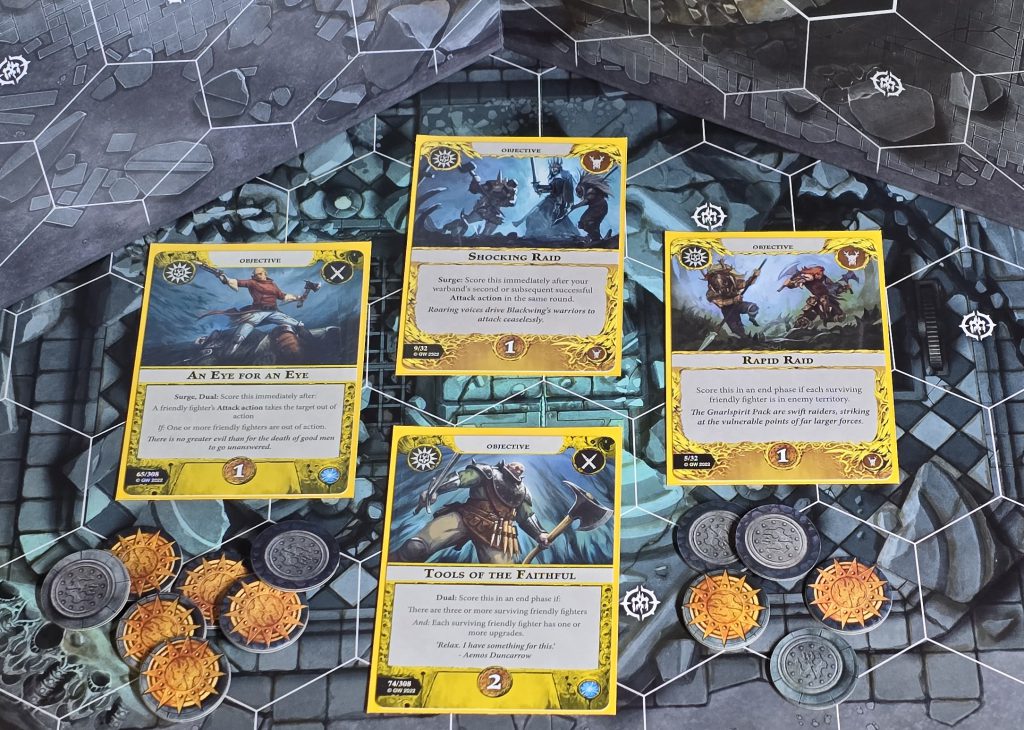
Glory serves a purpose other than merely being a rebranded type of victory points in Underworlds, though. Half of your power deck (so 10 of your 20 cards in that deck) are upgrades. These require you to spend one of your earned glory points (flip the double sided token over from the colorful side to the grey side) before you’re able to equip them to your fighters. Upgrades range from weapons that grant new attack profiles to magical armor that enhances your fighter’s durability to the satisfaction of a job well done.
One important thing to note is that when you spend your glory, you’re not depleting your overall score. Unspent and spent glory are worth the same amount at the end of the game. This means the cost of playing upgrades is gated behind scoring some early glory, which makes those previously mentioned surges even more important. Getting some early seed glory means you can afford to play out these upgrades to enhance your team and ensure the rest of your game goes more smoothly.
The last remaining type of cards are the other half of your power deck. These are gambits and serve the role of being a bucket that captures everything else. If it helps, think of them like instants or sorceries from Magic: the Gathering, or perhaps as stratagems from 40k – a wide variety of effects that further your gameplan, whether it’s a valuable push to reposition a fighter, a short term boost to an attack, or putting a scorpion in someone’s boots to mess up their plans. Aside from the ploys just mentioned, you’ll also find spells in this category which will require a wizard in your warband to cast it before the spell takes effect.

Warbands
One of the most eye-catching aspects of Underworlds has to be the warbands. Games Workshop has had decades to hone their sculpting game, and in my opinion the sculpts of Underworlds are often the prime showcase of the fruits of their labor. They’re full of character, have dynamic poses, and are just plain cool looking. An additional impressive fact is that they’re all the “easy to build” variety of models that can be assembled just with the push-to-fit pegs and not require any glue. I’d not suggest actually doing that, but I imagine it’s an extra bit of engineering that goes into these sculpts.
Each fighter in a warband has their own fighter card with their game stats on it. They’re basically baseball cards for skeletons and dwarves! These cards tell you how far your fighter can move, what attacks they can make, how hard it is to punch them in the face, how many punches their face can take, and any other special rules that pertain to them. One of the special rules that every fighter card has is their inspire condition. See, these cards are all double sided. The uninspired side is where they start, but once a fighter meets their inspire condition, the card flips over and your fighter essentially levels up.
I particularly enjoy the creativity that the developers have used when assigning inspire conditions. Some warbands all inspire at once, some fighters inspire individually, and there are some warbands where each fighter has unique inspire conditions. It is as varied as you could want. Conditions can be straightforward (you give the fighter an upgrade), some that are simple but require planning (flying a ghost through an enemy model), and some that are just amusing (a warband of three Slaaneshi daemons, each of which will inspire when their specific rival in the warband fails at a task or dies because they all hate each other).
Since Underworlds is set in the Age of Sigmar universe, each warband belongs to one of the four grand alliances. Mechanically, this doesn’t really matter anymore. In the past, there were cards that were restricted to certain grand alliances but things have changed and that isn’t relevant these days. It does allow us to take a look at the warbands in easier to digest chunks, though!
Death
Since this is my article, I’m going to start with one of my favorite groups of warbands first. At the time of writing, there are 12 potential warbands in the death grand alliance. Ghosts, skeletons, vampires, ghouls, and zombies. Oh my. Some of my favorites here include:
Lady Harrow’s Mournflight: Four Nighthaunt banshees that really play up the ghostly aspect of their nature. They inspire by flying through enemies and have some nasty tricks available in their faction deck. I’m particularly fond of the sculpts and how they have an option to play defensively.
Zondara’s Gravebreakers: One of the more recent warbands, this is a home run in terms of flavor and mechanics. A necromancer travels with her lover who has been cursed into being a werewolf. She seeks to wrest secrets from the realm itself to find a cure, and has her zombie minions around to help dig up clues to the answer she so desperately craves.
The Crimson Court: Four vampires, each with solid stats to be threatening on their own. They have a mechanic where they are constantly battling with their hunger. If they let it go unchecked, they become bloodthirsty. If they can overcome their hunger, they will inspire. They’re a flexible warband that can be built in a variety of ways in the formats with deck building.

Chaos
Closely after death in my personal rankings is chaos. If you’re at all familiar with the Warhammer settings, either Age of Sigmar or 40k, you can guess what’s in here. You’ll have daemon warbands of all four classic flavors, the mortals who throw in their lot with the daemonic forces, and an unhealthy smattering of rats from their various clans. There are currently 15 options in this grand alliance.
Thricefold Discord: These are the Slaanesh daemons I mentioned earlier. They hate each other, they constantly bicker, and the mechanics represent it perfectly. Their deck also features false gift upgrades that you can play on your fighters or the opponent’s fighters. Each comes with an upside and a massive downside, and being able to decide when to use them on your fighters or the opponent’s can swing the game.
Gnarlspirit Pack: These Darkoath warriors happen to be the warband that Craig played to win the GHO Underworlds event. I read the new Darkoath book as my first foray into AoS fiction and, while it wasn’t mind blowing, it was pretty neat and painted the Darkoath in a humanizing light.
Gorechosen of Dromm: Three mortal worshipers of Khorne who can, but don’t necessarily need to, play a “Rar! I charge!” style. They very much want a brawl in the middle, but their deck is built in a way that they can afford to hang back and force the enemy to come to them – sometimes literally.

Destruction
Clocking in at 11 warbands, this is where you’ll find your greenskins of various weight classes. Hefty or sinewy orruks, goblins with a wide variety of funny hats (sometimes riding wolves), and ogors dressed as pirates are among the options present here.
Mollog’s Mob: Mollog, a troggoth terror with a giant club, wades through enemy models giving them the thumpin’. He’s accompanied by some extra weird squigs and a dancing mushroom. This warband was one of the earlier ones released, but GW recently revamped it (among others) to bring it into the modern Underworlds era.
Da Kunnin’ Krew: I’ll be honest, I wasn’t hot on these guys before someone played against me with them. This warband has so many movement shenanigans potential, and since you’re normally limited to 12 activations, being able to get any extra move actions out of sequence is quite valuable. The models themselves have some big weirdo energy and also big sticks to poke with.
Grinkrak’s Looncourt: Goblin knights! They go on quests, the leader can dub his fellows to inspire them, and there’s a goblin standing on another goblin’s shoulders to fire a squig from a slingshot catapult. This is one of the higher model count warbands, and as such they can lean into the objective based game plans fairly well.

Order
Order has the most warbands of the four grand alliances, clocking in at a whopping 20. Much like in Age of Sigmar, to me it feels like a less defined theme and more “all the folks who don’t fit into the previous buckets and/or hate Chaos a whole lot.” As such, there’s a ton of variety found here. You’ve got multiple flavors of Stormcast, elves (moist, Captain Planet-themed, angry, sneaky, or in tree mechs), humans (kind-of-weird to super weird), dwarves (naked or cosplaying as Iron Giant), and lizardmen (not nearly enough though).
Cyreni’s Razors: I have to give a special mention to this warband because one of their fighters is the entire reason I looked into this game. Cephanyr the squid is such a charming model. The rest of the warband is cool too if you like soggy elves. They have a tidal themed inspire mechanic where they inspire and uninspire based on what activation it is in each turn.
Xandire’s Truthseekers: I’m not terribly hot on most Stormcast, but Xandire and her crew are among the exceptions for me. The fighters are all specialists of different things – you have the accurate melee plus wizard package in Xandire herself, the beat stick role filled by Dhoraz and his big hammer, and Luxa sports a very long ranged bow to harass her enemies from afar. Also there’s a bird.
Hexbane’s Hunters: A favorite of fellow Goonhammer author marquis_of_peaches, these witch hunters pack a punch, two sacks full of dirty tricks, and what feels like the ability to score just from your opponent trying to play the game. If you liked playing with the hidden pistol in Assassin’s Creed, this warband is up your alley.
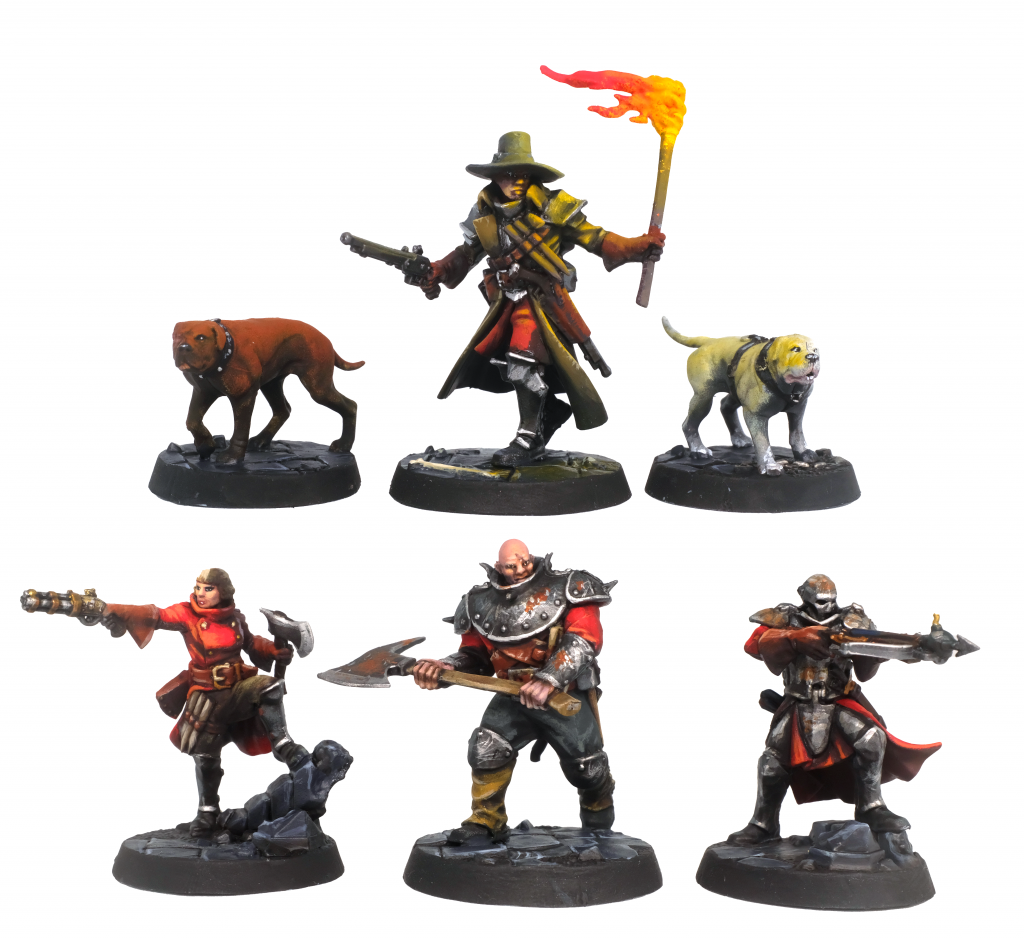
Gameplay Formats
If you looked into Underworlds in the past, or perhaps dabbled in it years ago, the way the game is structured now may look fairly different than what you recall. Since I only came to the game within the last year, I’m not familiar with The Game That Was but I’ve picked up on a few things from conversing with veterans. The biggest thing, and the entire reason I wound up getting into the game instead of passing on it, is that the card chasing element has been removed.
Let’s unpack this last statement. The release structure of the game has shifted a small amount, but for the most part it’s the same as it was. There’s a large core box that’s released roughly twice a year and this contains two warbands, two universal rivals decks (we’ll get into these later), and the boards/dice/tokens. The latest example of this is the Wintermaw box. After each of the core boxes, there’s a period where a few different individual warbands are released as well as individual different universal rivals decks. Recent examples here include Zondara’s Gravebreakers (a warband) and Rimelocked Relics (a rivals deck). In the past, each of these releases contained cards that you could potentially want to have access to for building your decks, which meant if you wanted to be competitive you were incentivized to purchase every single release, regardless of whether it was a warband you had any interest in or not.
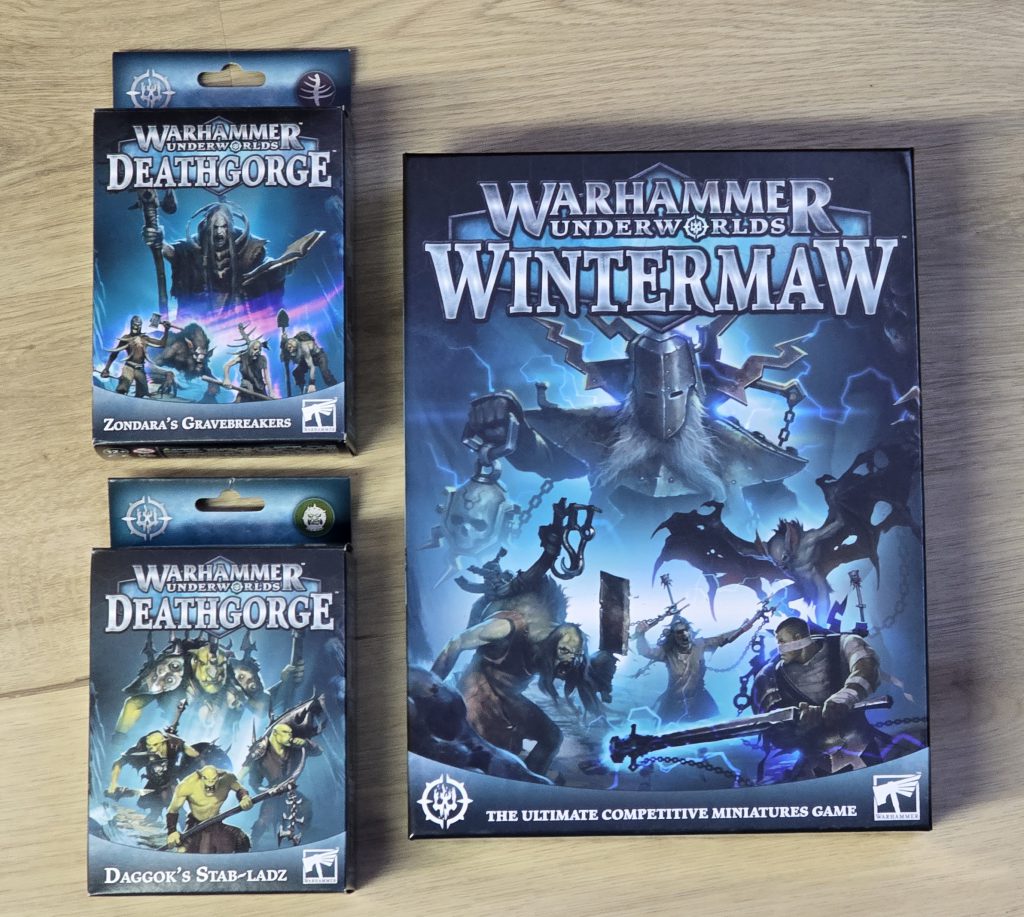
As I’ve hinted at, this is fortunately no longer the case. We can thank the following formats and a generous rotation for making the game substantially more approachable for new players, casual players, or even the most competitive minded players who don’t want to spend more than the cost of a AAA video game every year and still remain on the bleeding edge of the meta. Let’s break down the three current formats that are supported by Games Workshop in a very quick and hopefully easy to understand manner.
In all formats, you’ll be bringing your warband’s fighter models and their fighter cards, a 12 card objective deck, and a 20 card power deck. The only thing differentiating the formats is what cards can make up those objective and power decks. Each of the warbands have their own 12 card objective and 20 card power decks that come packaged with the fighter models and cards. There are also the previously mentioned Universal Rivals decks (I told you we’d get to these soon) and these are themed decks that also consist of a 12 card objective deck and a 20 card power deck, but have no models associated with them.
Rivals: In Rivals, each player will bring their fighters and either their warband’s objective/power decks or a universal rivals deck. This format is the most approachable as a newcomer because it contains zero deck building, and if you pick up one of the stand alone warband releases, you have everything you need to play (minus dice/boards/tokens) in a single purchase. It’s worth noting that some of the very early warbands do not have full decks – this was back when GW was still hammering out how they wanted Underworlds to work, so if you have your heart set on playing someone like Magore’s Fiends, you’ll have to pair them with a universal rivals deck in this format.
Nemesis: Similar to Rivals above, this format instead has you build your decks using the card pool created by combining your warband’s decks and a universal rivals deck. This means you’ll choose 12 of your 24 objective cards to make your objective deck. Likewise, you’ll choose 20 of your 40 power cards to make that deck. You can mix and match between the two as much or as little as you want. This allows you to do some limited deck building to fill in weaknesses or double up on your warband’s strengths. Currently, this is the format that GW is supporting the most. It’s the most common format to see events run as in North America and (I believe) England. It’s also the format that the World Championship of Warhammer runs.
Relic/Championship: Building off of Nemesis, this time you’re building your decks out of your warband’s cards and all the (currently legal) universal rivals decks, plus a pack of Essentials cards that have some generic staples from the past. At the time of writing this, that means there are 14 universal rivals decks plus your warband’s deck, yielding a pool of over 200 objective cards and 340 power cards for any particular championship build. This can be daunting for folks, both in terms of decisions needing to be made in culling such a large pool down and also in just obtaining the cards. From my understanding, this is the closest analog to how Underworlds used to be. It is currently less popular than the other two formats although it does have some staunch devotees. I haven’t personally played it (yet) so I will leave it at that.
Also, technically, Championship is a subset of the Relic format. Don’t worry about Relic – it’s the wild west, free-for-all where ever card ever printed is legal and I’m pretty sure nobody actually plays it. Championship is the matched play version of Relic with some sanity restrictions. Unless you’re elbow deep in Underworlds before even reading this article, there’s not really any reason to worry about anything other than Rivals or Nemesis for now.
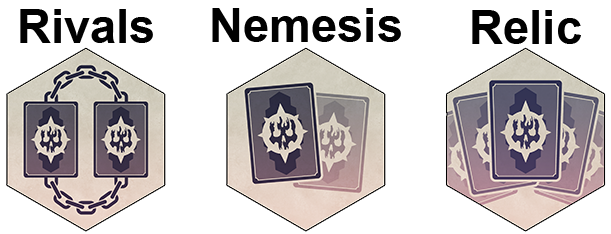
Rotation
Let me state this clearly and prominently: Warbands do not rotate. Sure, GW could change their minds the day after I write this but so far there’s been no indication that this is something they’re considering. If you have a warband that you thoroughly enjoy, GW isn’t going to legends those models in Underworlds.
Now that we know GW isn’t going to come for your Garrek’s Reavers, there is a rotation element to the formats listed above. The legal universal rivals decks and game boards are the ones which have come out in the last two years. For the decks, this includes the two that are included in each of the core boxes (for example, Wintermaw has Hungering Parasite and Rimewyrm’s Bite) as well as the individually released ones in between core sets (the latest two of which were Rimelocked Relics and Malevolent Masks). For the game boards, this includes the ones in each of the core boxes as well as any boards released in the periodic starter sets that GW puts out. So far, these have been reprints of some “classic” boards from early in the game’s life.
This allows players to have a relatively smooth entry point into the game. They do not have to worry about playing catch up and hunting down dozens of out of print cards or boards. If you want to play Rivals, you just need a few boards, dice, and a single warband (either an individual release or one of the ones in a core box). If you want to play Nemesis, it’s the same thing but adding in a universal rivals deck.
The current version of the rules are always available over at the Warhammer Community download page. As of the time of writing, those would be the Wintermaw rules. Grab the PDF and take a look. The game has never been easier to get into! So what are you waiting for?
If you have any questions about the game, please don’t hesitate to ask. You can do so in the comments here, or if you’re a Patreon supporter for Goonhammer you can hop into the Underworlds channel in the Goonhammer Discord and ping me or any of the other incredibly cool people who hang out in there.
Finally, I’d also like to give a special shout out to my wife because she’s incredibly awesome.
Have any questions or feedback? Drop us a note in the comments below or email us at contact@goonhammer.com. Want articles like this linked in your inbox every Monday morning? Sign up for our newsletter. And don’t forget that you can support us on Patreon for backer rewards like early video content, Administratum access, an ad-free experience on our website and more.







